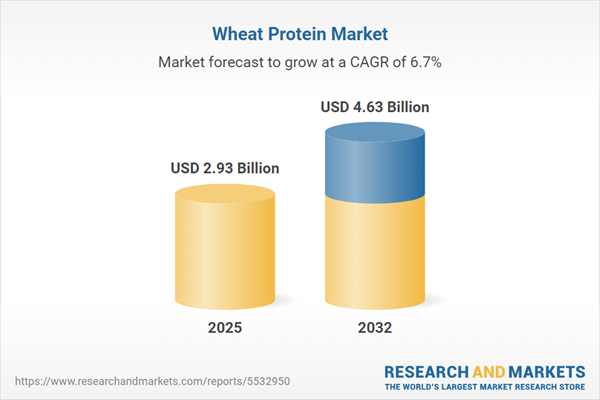Speak directly to the analyst to clarify any post sales queries you may have.
Wheat protein is becoming integral to manufacturers' product innovation as plant-based nutrition and cleaner labels influence purchasing decisions across food, feed, and supplement industries. This report delivers actionable insights for senior leaders navigating the evolving wheat protein market and its emerging opportunities.
Market Snapshot: Growth Trajectory of the Wheat Protein Market
The wheat protein market grew from USD 2.74 billion in 2024 to USD 2.93 billion in 2025 and is projected to continue expanding at a CAGR of 6.73%, reaching USD 4.63 billion by 2032. Increased demand for plant-derived functional proteins and advances in extraction technologies are driving the adoption of wheat protein across diverse industries. Heightened focus on flexitarian and vegan product development is expanding its footprint in both established and emerging regions.
Scope & Segmentation of the Wheat Protein Market
This comprehensive report provides a segmented view, empowering decision-makers to assess growth opportunities and risk factors efficiently.
- Product Types: Concentrate, Hydrolysate, Isolate
- Applications: Animal Feed, Bakery (Bread, Cakes, Pastries), Beverages, Dietary Supplements (Meal Replacements, Sports Nutrition, Weight Management), Meat Products
- Forms: Liquid, Powder
- Distribution Channels: Direct Sales, Distributors, Food Service, Online Retailers
- End Users: Feed Industry, Food Industry, Pharmaceutical Industry
- Geographies: Americas (North America: United States, Canada, Mexico; Latin America: Brazil, Argentina, Chile, Colombia, Peru), Europe Middle East & Africa (Europe: United Kingdom, Germany, France, Russia, Italy, Spain, Netherlands, Sweden, Poland, Switzerland; Middle East: United Arab Emirates, Saudi Arabia, Qatar, Turkey, Israel; Africa: South Africa, Nigeria, Egypt, Kenya), Asia-Pacific (China, India, Japan, Australia, South Korea, Indonesia, Thailand, Malaysia, Singapore, Taiwan)
- Key Companies Covered: Archer Daniels Midland Company, Cargill, Incorporated, Ingredion Incorporated, Roquette Frères S.A., MGP Ingredients, Inc., Manildra Group Pty Ltd, AGRANA Beteiligungs-AG, The Scoular Company, CHS Inc., Tate & Lyle PLC
Key Takeaways for Senior Leaders
- Flexitarian, vegan, and health-conscious consumer trends are boosting demand for wheat protein in foods, supplements, and animal feed, supporting deeper market penetration.
- Emerging technologies, such as enzymatic hydrolysis and ultrafiltration, are enhancing product performance and enabling more customized formulations for bakery, sports nutrition, and specialized applications.
- Advancements in allergen management and gluten reduction are increasing wheat protein’s viability for clean-label, allergen-sensitive, and diverse geographic markets.
- Supply chain digitization and enhanced traceability are improving risk management and enabling companies to meet evolving regulatory expectations and transparency demands.
- Strategic portfolio expansion and partnerships, including investments in specialty isolates and hydrolysates, are allowing key players to address niche requirements in sports and therapeutic nutrition.
Impact of 2025 Tariffs on Wheat Protein Supply Chains
Incoming tariff measures in the United States, set for 2025, will alter sourcing strategies and pricing dynamics for global wheat protein stakeholders. Companies reliant on imports are exploring new supplier partnerships in emerging regions, renegotiating contracts to hedge against cost volatility, and investing in digital tools to gain end-to-end supply chain visibility. These actions emphasize the sector’s flexibility in adjusting to regulatory change and maintaining competitive positioning despite external pressures.
Research Methodology & Data Sources
This report relies upon thorough secondary research across regulatory sources, industry journals, and trade association publications, alongside primary interviews with R&D, procurement, and regulatory experts. The use of triangulation and validation through proprietary findings and expert reviews helps ensure analytical rigor and actionable accuracy.
Why This Wheat Protein Market Report Matters
- Supports informed strategic decisions with detailed segmentation, regional trends, and competitor insight not found in summary overviews.
- Provides visibility into changing technologies and regulatory factors to help de-risk procurement and innovation planning.
- Equips leaders with targeted recommendations on supply chain, product development, and market positioning to enable value creation.
Conclusion
The wheat protein market is characterized by strong innovation, fast-evolving consumer preferences, and dynamic regional shifts. Leaders who act on timely insights from this report can optimize portfolios and build resilience in a competitive, growth-focused landscape.
Additional Product Information:
- Purchase of this report includes 1 year online access with quarterly updates.
- This report can be updated on request. Please contact our Customer Experience team using the Ask a Question widget on our website.
Table of Contents
3. Executive Summary
4. Market Overview
7. Cumulative Impact of Artificial Intelligence 2025
Companies Mentioned
The companies profiled in this Wheat Protein market report include:- Archer Daniels Midland Company
- Cargill, Incorporated
- Ingredion Incorporated
- Roquette Frères S.A.
- MGP Ingredients, Inc.
- Manildra Group Pty Ltd
- AGRANA Beteiligungs-AG
- The Scoular Company
- CHS Inc.
- Tate & Lyle PLC
Table Information
| Report Attribute | Details |
|---|---|
| No. of Pages | 199 |
| Published | November 2025 |
| Forecast Period | 2025 - 2032 |
| Estimated Market Value ( USD | $ 2.93 Billion |
| Forecasted Market Value ( USD | $ 4.63 Billion |
| Compound Annual Growth Rate | 6.7% |
| Regions Covered | Global |
| No. of Companies Mentioned | 11 |









